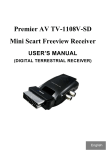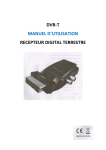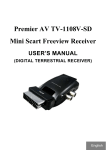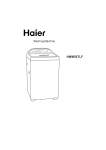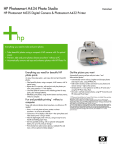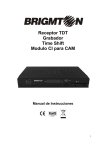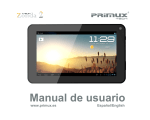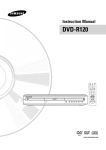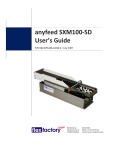Download Akura SCART DVB-T User`s manual
Transcript
DVB-T USER’S MANUAL DIGITAL TERRESTRIAL RECEIVER Index 1. 2. 3. 4. 5. 6. INTRODUCTION.............................................................................2 1.1. Features..................................................................................2 1.2. Safety Information...................................................................2 DEVICE OVERVIEW.......................................................................4 2.1. Main Unit.................................................................................4 2.2. Remote Control Unit................................................................5 SETTING UP...................................................................................5 3.1. Connecting to a TV..................................................................5 3.2. Connecting to a DVD/VCR player...........................................6 3.3. Channels Initial Installation......................................................7 DVB-T BASIC OPERATION............................................................8 4.1. Channel List............................................................................8 4.2. Favourite List...........................................................................8 4.3. Electronic Program Guide (EPG)............................................8 4.4. Soundtrack and Subtitles Selection.........................................9 4.5. Displaying Program Information..............................................9 4.6. Teletext..................................................................................10 4.7. DVB-T recording....................................................................10 MAIN MENU..................................................................................10 DIGITAL TV...................................................................................11 6.1. 6.2. Channel Manager..................................................................11 6.1.1. Channel Organizer......................................................11 6.1.2. Channel sorting...........................................................12 6.1.3. Channel Grouping.......................................................12 6.1.4. Edit Channels..............................................................13 6.1.5. Delete All.....................................................................13 Installation.............................................................................13 6.2.1. Area Search................................................................13 6.2.2. Manual Search............................................................14 6.2.3. 6.3. 6.4. Automatic Search........................................................14 Configuration.........................................................................14 6.3.1. OSD............................................................................15 6.3.2. TV...............................................................................15 6.3.3. System etup................................................................15 6.3.4. Time............................................................................16 6.3.5. Wakeup Timer.............................................................16 6.3.6. Parental Lock..............................................................16 Software Upgrade.................................................................17 6.5. Factory Default......................................................................17 6.6. Version..................................................................................17 7. MOVIE, MUSIC ANDPHOTO........................................................17 8. GAMES..........................................................................................17 9. RECORDER..................................................................................17 9.1. Timer Recorder Function.......................................................18 9.2. Recording Files Playing.........................................................18 10. DISK MANAGER.........................................................................18 11. TROUBLE SHOOTING................................................................19 12. Appoint For Recording.................................................................19 13. SPECIFICATIONS.......................................................................19 1. INTRODUCTION Tune in the Digital Terrestrial Television connecting your T.12 to your TV and record your favourite programs in a easy and fast way. 1.1. Features Handy and intuitive user interface that supports the display of multilingual characters. Electronic Program Guide (EPG), Teletext and Parental Lock. Compatible with PAL, NTSC and SECAM TV systems. Channel manager mode to add, memorize favourites, sort and delete channels. TV programs recording function on USB device or SD/MMC memory card. 1.2. Safety Information To ensure reliable and safe operation of this equipment, please read carefully all the instructions in this user guide, especially the safety information below. CAUTION: TO REDUCE THE RISK OF ELECTRIC SHOCK, DO NOT REMOVE COVER (OR BACK). NO USER-SERVICEABLE PARTS INSIDE. REFER SERVICING TO QUALIFIED SERVICE PERSONNEL. The lightening flash with arrowhead symbol, within an equilateral triangle is intended to alert the user to the presence of un-insulated “dangerous voltage” within the products enclosure that may be of sufficient magnitude to constitute a risk of electric shock to the persons. The exclamation point within an equilateral triangle is intended to alert the user to the presence of important operating and maintenance (servicing) instructions in the literature accompanying the appliance. WARNING: TO REDUCE THE RISK OF FIRE OR ELECTRIC SHOCK, DO NOT EXPOSE THIS APPLIANCE TO RAIN OR MOISTURE. CAUTION: Use of controls or adjustments or performance of procedures other than those specified herein may result in hazardous radiation exposure. Please, carefully study this manual and always keep it available. There are, however, some installation and operation precautions which you should be aware of: (1) READ INSTRUCTIONS: All the safety and operating instructions should be read before the product is operated. (2) RETAIN INSTRUCTIONS: The safety and operating instructions should be retained for future reference. (3) HEED WARNINGS: All warnings on the product and in the operating instructions should be adhered to. (4) FOLLOW INSTRUCTIONS: All operating and use instructions should be followed. (5) CLEANING: Unplug this product from the wall outlet before cleaning. Do not use liquid cleaners or aerosol cleaners. Use a damp cloth for cleaning. (6) ATTACHMENTS: Do not use attachments not recommended by the product manufacturer as they may cause hazards. (7) WATER AND MOISTURE: Do not use this product near water – for example, near a bath tub, wash bowl, kitchen sink, or laundry tub - in a wet basement or near a swimming pool and the like. (8) ACCESSORIES: Do not place this product on an unstable cart, stand, tripod, bracket or table. The product may fall, causing serious injury to a child or adult and serious damage to the product. Use only with a cart, stand, tripod, bracket or table recommended by the manufacturer or sold with the product. Any mounting of the product should follow the manufacturer’s instructions and should use a mounting accessory recommended by the manufacturer. A product and cart combination should be moved with care: Quick steps, excessive force and uneven surfaces may cause the product and cart combination to overturn. (9) VENTILATION: Slots and openings in the cabinet are provided for ventilation and to ensure reliable operation of the product and to protect it from overheating, and these openings must not be blocked or covered. The openings should never be blocked by placing the product on a bed, sofa, rug, or other similar surface. This product should not be placed in a built-in installation such as a bookcase or rack unless proper ventilation is provided or the manufacturer’s instructions have been adhered to. (10) POWER SOURCES: This product should be operated only from the type of power source indicated on the marking label. If you are not sure of the type of power supply to your home, consult your product dealer or local power company. For products intended to operate from battery power, or other sources, refer to the operating instructions. (11) GROUNDING OR POLARIZATION: This product may be equipped with a polarized alternating-current line plug (a plug having one blade wider than the other).This plug will fit into the power outlet only one way. This is a safety feature .If you are unable to insert the plug fully into the outlet, try reversing the plug .If the plug should still fail to fit, contact your electrician to replace your obsolete outlet. Do not defeat the safety purpose of the polarized plug. (12) POWER-CORD PROTECTION: Power-supply cords should be routed so that they are not likely to be walked on or pinched by items placed upon or against them, paying particular attention to cords at plugs, convenience receptacles, and the point where they exit from the product. (13) PERCEPTIVE ATTACHMENT PLUG: The product is equipped with an attachment plug having overload protection. This is a safety feature. See instruction manual for replacement or resetting of protective device. If replacement of the plug is required, be sure the technician service has used a replacement plug specified by the manufacturer that has the same overload protection as the original plug. (14) OUTDOOR ANTENNA GROUNDING: If an outside antenna or cable system is connected to the product, be sure the antenna or cable system is grounded so as to provide some protection against voltage surges and built-up static charges. Article 810 of the National Electrical Code, ANSI/NFPA 70, provides information with regard to proper grounding of the mast and supporting structure, grounding of the leadin wire to an antenna discharge unit, size of grounding conductors, location of antenna-discharge unit, connection to grounding electrodes, and requirements for the grounding electrode: (15) LIGHTNING: For added protection for this product during a lightning storm, or when it is left unattended and unused for long periods of time, unplug it from the wall outlet and disconnect the antenna or cable system. This will prevent damage to the product due to lightning and power-line surges. (16) POWER LINES: An outside antenna system should not be located in the vicinity of overhead power lines or other electric light or power circuits, or where it can fall into such power lines or circuits. When installing an outside antenna system, extreme care should be taken to keep from touching such power lines or circuits as contact with them might be fatal. (17) OVERLOADING: Do not overload wall outlets, extension cords, or integral convenience receptacles as this can result in a risk of fire or electric shock. (18) OBJECT AND LIQUID ENTRY: Never push objects of any kind into this product through openings as they may touch dangerous voltage points or short-out parts that could result in a fire or electric shock. Never spill liquid of any kind on the product. (19) SERVICING: Do not attempt to service this product yourself as opening or removing covers may expose you to dangerous voltage or other hazards. Refer all servicing to qualified service personnel. (20) DAMAGE REQUIRING SERVICE: Unplug this product from the wall outlet and refer servicing to qualified service personnel under the following conditions: When the power-supply cord or plug is damaged. If liquid has been spilled, or objects have fallen into the product. If the product has been exposed to rain or water. If the product does not operate normally by following the operating instructions. Adjust only those controls that are covered by the operating instructions as an improper adjustment of other controls may result in damage and will often require extensive work by a qualified technician to restore the product to its normal operation. If the product has been dropped or damaged in any way. When the product exhibits a distinct change in performance – this indicates a need for service. (2) REPLACEMENT PARTS: When replacement parts are required, be sure the service technician has used replacement parts specified by the manufacturer or have the same characteristics as the original part. Unauthorized substitutions may result in fire, electric shock, or other hazards. (22) SAFETY CHECK: Upon completion of any service or repairs to this product, ask the service technician to perform safety checks to determine that theproduct is in proper operating condition. (23) WALL OR CEILING MOUNTING: The product should be mounted to a wall or ceiling only as recommended by the manufacturer. (24) HEAT: The product should be situated away from heat sources such as radiators, heat registers, stoves, or other products (including amplifiers) that produce heat. 2. DEVICE OVERVIEW 2.1. Main Unit ANT IN: CONNECT TO ANTENNA CONNECT TO THE POWER SUPPLY CONNECT TO USB CONNECT TO INFRARED RECEIVER ANT OUT: CONNECT TO ANTENNA SD/MS/MMC 2.2. Remote Control Unit key 0~9 TV/RADIO oPR MENU function key function Turn ON/OFF the receiver EPG Display EPG (Electronic Program Guide) Mute audio output INFO Display channel info Numerical pad Switch TV or Radio channels Go to previous program Display Main Menu AUDIO TXT Changing the audio mode Switch to teletext mode SUBTITLE Display subtitles FAV Display Favourite list Enter the mode of sample images on the screen . EXIT Exit current menu PR+, PR- Changing the channel up Press once to pause. or down the channel you PAUSE Press again to return to are watching normal Adjusting volume Press this key start to RECORD record the program Execute the selected OK/List option in the menu screen Or enter the option. STOP Stop to record program Function buttons, Selection of function in the teletext. 3. SETTING UP 3.1. Connecting to a TV 3.2. Connecting to a DVD/VCR player 3.3 Channels Initial Installation If this is the first time for you to use the DVB-T receiver, after pressing POWER button at the screen will appear the Init Install menu. In the OSD Language item, you could set up the language of the on screen menus. At the Area item you can choose your current area, where you are going to search channels. Once the OSD language and area are selected, press OK/LIST button and select YES on the popup window to start channels installation. Wait a moment while the unit completes the channels searching process. The channels founded will be stored automatically 4. DVB-T BASIC OPERATION Press PR+ or PR- in your remote control unit to select a channel or just enter the channel number with the numerical pad. Press the TV/RADIO button to switch between TV and radio channels. To close the channels list press EXIT. Use the buttons -\ or [+ to decrease or increase the volume of the DVB-T receiver. You can silence the sound from the receiver by pressing MUTE button on the remote control unit. 4.1. Channel List You can select the channel by using the lists you have created (see chapter 6.1. Channel Manager). Once the list has been created, press OK/LIST to show tha channels list and press PR+ or PR- to select the one you wish. Press OK/LIST to display it. Use -\ or [+ display the previous or next genre or press TV/RADIO button to switch between TV and radio channels lists. Press EXIT to close the chanels list. Press INFO to enter the operation guide while the channels list is displayed. 4.2. Favourite List You can set your own favourite channels lists too (see chapter 6.1. Channel Manager). Press FAV to display the favourite list, press PR+ or PR- to select a channel and press OK/LIST to display it. Use TV/RADIO to switch between TV and radio channels. Press EXIT to close the favourite list. Press INFO to enter the operation guide while the favourite list is displayed. 4.3. Electronic Program Guide (EPG) You can also select the channel you wish form the Electronic Program Guide (EPG). As in the channels list, the EPG interface displays a list of the stored channels along with information on what programmes are being broadcast. Press EPG to enter the EPG menu, press PR+ or PR- to highlight a channel and the program information will be shown. Press the RED button to display the programs daily, the GREEN one to display the programs weekly, the YELLOW one to display info about the program you have selected and the BLUE button to access the timer and schedule a recording. Use TV/RADIO to switch between TV and radio channels and press EXIT to switch to the selected channel and close the EPG menu. Press INFO button to enter the operation guide while the EPG is displayed. 4.4. Soundtrack and Subtitles Selection Some programs are broadcast in two or more languages simultaneously. The soundtrack language can be selected by pressing LANG in the remote control unit. If the program is broadcast in just one language, press LANG and the buttonsor to choose the audio modes between STEREO, LEFT MONO and RIGHT MONO. In the same way, if a program is broadcast with one or more subtitles languages, you can display them by pressing SUBTITLE in the remote control unit and usingor “” to “” show the available options. 4.5. Displaying Program Information You can read the current program information by pressing INFO in the remote control unit. Press the button again and the frequency, bandwidth as well as signal and quality levels of the channel will be displayed. Press INFO once again to hide the program information window. You can read too the program information daily and weekly by using the EPG (see chapter 4.3. Electronic Program Guide). 4.6. Teletext Press TEXT and after OK/LIST to access the Teletext window. You can use PR+ or PR- or to display the previous or next pages,or input directly the page number using the numerical pad. Use the colour buttons to short cut to the pointed pages. Press EXIT to close the Teletext window. 4.7. DVB-T recording Your AKDVB30 allows you to record your favourite programs and store them in a USB device you must connect to the receiver. See chapter 9. Recording to make a recording of the program you wish. 5. MAIN MENU From the Main Menu you can activate several functions and adjust many settings as you wish. Press MENU button in your remote control unit (or in the main unit) and your AKDVB30 Main Menu will be dispayed: Press PR+ or PR- to selct the option you wish and after OK/LIST to enter. Press EXIT to close the menu. 6. DIGITAL TV 6.1. Channel Manager In the Digital TV Menu, select Channel Manager and press OK/LIST to enter. In this submenu you will find the following settings: 6.1.1. Channel Organizer The Channel Organizer submenu could manage the searched DVB-T channels. Press PR+ or PR- to select the channels. Once a channel is selected, press the RED button to set up the channel as the Favourite channel. Press the GREEN buton to delete the channel. Press the YELLOW button to move the channel to another place in the list (select the new position you wish and press OK/LIST ). Press the BLUE button to lock the channel; if you want to watch this channel later, you will need input the correct password of the parental lock. Select a channel and press or to display the rename channels interface. Use the numerical pad and the coloured buttons to enter the new name and press OK/LIST button to confirm and exit the rename interface. Press continuously EXIT until close the system settings menu, and the unit will update the settings automatically (deleting the channels set up as “Delete”). 6.1.2. Channel sorting The Channel Sorting submenu shows information of the channel storage, including the channel’s Serial Number, Channel Name, Frequency and Bandwidth. In this submenu you may sort the channels list depending on several parameters (area, alphabetical order, LCN -Logical Channel Number-,…). 6.1.3. Channel Grouping In the Channel Grouping submenu you could classify the stored channels. Press the direction buttons PR+ or PR- to choose a channel and then press a number button from 1 to 8 to classify the channels as None, News, Science, Sports, Movies, Kids, Music or Fashion. Once the setting has been finished, press continuously EXIT until close the TV Digital Menu and the device will save the settings automatically. 6.1.4. Edit Channels In the Edit Channel submenu, pressing the RED button in the remote control unit to add channels or press the YELLOW button to edit the channels. 6.1.5. Delete All In Delete All submenu you could delete the whole channels list. Enter the correct password of the parental lock and then choose to delete TV or Radio channels. 6.2. Installation In the Digital TV menu, select Installation and press OK/LIST to confirm. In this submenu you will find the following settings. 6.2.1. Area Search Select the Area Search and press OK/LIST to enter the area search submenu. Select the zone and press OK/LIST to start to search channels according to the area setup. 6.2.2. Manual Search Select Manual Search and press OK/LIST to enter the manual search submenu. Select a frequency and press OK/LIST to start to search channels in the selected frequency. 6.2.3. Automatic Search Select Automatic Search and press OK/LIST to enter the automatic search submenu. Select a start frequency, an end frequency and a bandwidth and press OK/LIST to start to search channels in the selected range. 6.3. Configuration In the Digital TV Menu, select Configuration OK/LIST to enter. In this submenu you will find the following settings. 6.3.1. OSD Select OSD and press OK/LIST to enter the information settings submenu. OSD: Pressing or you can set up the colour of the menu. Hora en OSD: Pressing or you can activate or deactivate the Time Display function (if it is active, the time will be displayed on the upper right corner of the screen). OSD Timeout: You can set the staying time of the OSD texts on the screen. OSD Trans: You can set the transparency of the menu. OSD Language: Youcan set the language of the menu. 1st Audio Language: Set the language you wish for the audio. 2nd Audio Language: Set a alternative language for the audio. 6.3.2. TV Select TV and press OK/LIST to enter the video output settings menu. Display Mode: Pressing or you can change the video standard. Aspect Ratio: Pressing or you can switch the scale of the screen between 4:3LB, 4:3PS and 16:9. Video Out: You can choose between composite video (CVBS) and RGB outputs. Brightness, Contrast, Hue and Saturation: Choose your desired values for these settings. 6.3.3. System etup Select System setup and press OK/LIST to enter the general settings submenu. EQ Setup: Adjust the audio equalizar setup. Surround: Pressing or you can change the sound’s surrounding effect setup. Active Antenna: Select the OFF option to this setting by default. LCN: Once the search has been finished, active the LCN function to arrange the channels according to the LCN (Logical Channel Number). Area: Select the zone to search the channels. 6.3.4. Time Select Time and press OK/LIST to enter the system’s time settings submenu. Timer Mode: Select Auto to use the DVB-T program time (you can set up the GMT Offset and the summer time). Choose Manual to set up manually time and date. Date: Use the numerical pad to enter manually the current date. Time: Use the numerical pad to enter manually the current time. GMT Offset: Use or to set up the relative time difference to the Greenwich Time. Summer Time: Use or to enable or disable the automatic switch to the summer time. 6.3.5. Wakeup Timer Select Wakeup Timer and press OK/LIST to enter the scheduler settings submenu. See chapter 9.1 Timer Recorder Function to schedule your AKDVB30 to do recordings. 6.3.6. Parental Lock Select parantal Lock and press OK/LIST to enter the channels lock settings submenu. In this submenu you can set up your own password for channels locking. The password of the Parental Lock is 0000 by default. Input the correct old password twice before trying to set up a new password. 6.4. Software Upgrade Contact our customer’s attention service, or visit our website www. *******.com to check if there are software updates available for this product. 6.5. Factory Default In the Digital TV menu, select Factory Default and press OK/LIST to recover the default settings of the device when it left the factory. Enter the correct password of the parental lock, select YES and press OK/LIST to reset all the DVB-T settings to their defaulted status. 6.6. Version In the Digital TV menu, select Version and press OK/LIST to find information about the software and hardware versions of the DVB-T receiver. 7. MOVIE, MUSIC AND PHOTO Your AKDVB30 is equipped with a simplified function multimedia player that allows you to play certain kind of files. You can connect a USB device or a SD/MMC memory card to your AKDVB30 and play music in MP3 format, images and some kind of video files (as the files recorded by your AKDVB30). You must access the Main Menu by pressing “MENU” button to browse and play the multimedia files stored in the external memory. Select Movie, Music or Photos according to the type of file you want to play and press OK/LIST to confirm. Select the device and the folder where the files are stored and press OK/LIST to start to play. Press EXIT if you want to return to the file browser. NOTE: The USB multimedia player is an additional feature of this DVB-T receiver, therefore only the essential playback functions will be availe (Play, Pause, Stop,...). When playing some MPEG-4 video files (AVI) you may find some AV delay due the high quantity of resources that video decompression consumes from the system. The range of compatible video formats is limitated, please use a video player to play specific video files. 8. GAMES Select in the Main Menu the Games option to access the availables classic games. Select the one you wish and press OK/LIST to enter. 9. RECORDER You can do recordings of the DVB-T programs you wish. The recordings will be stored in the USB devise you have connected to your AKDVB30 previously. When the DVB-T program starts to be broadcasted, press RECORD in the remote controller to start to record. Press RECORD again to stop the recording and select YES to confirm the end of the recording. The recorded programs will be stored in the PVR folder of the root catalogue of the memorizer (if there is no this folder in the memorizer, the player will create one automatically). 9.1. Timer Recorder Function You can schedule your AKDVB30 to start a recording anytime you must set previously. To adjust the Wakeup Timer, press MENU to enter the Main Menu and select the Recording option (you can also access this function by selecting DIigital TV-Configuration-Wakeup Timer or from the EPG interface by pressing the BLUE button). The following options will be shown: Timer Number: Is the serial number of waking up the mission in fixed time. The player can set up 8 missions with the fixed time, with serial numbers from 1 to 8. Timer Mode: Is the period enactment of waking up the missions in the fixed time. You could choose just once, once a day, once a week or once a year. Wakeup Mode: Is the program mode. You could choose to turn on or turn off the unit, switch to a certain channel or send a message at the screen. Wakeup Channel: It is the channel that must be recorded at the selected time. Wakeup Date: It is the day when the wakeup timer must be active to start to record. Pressing the direction buttons left or right you can open the calendar to choose the date. On Time: It is the hour when the wakeup timer must be active. You can set this time with the numerical pad. Duration: Is the duration of being waken up according to the channel mode (00:05 means to wake up to the reserved channel and broadcast for 5 minutes, and then switch back to the previous channel). Once you have finished the setup, press OK/LIST and exit the Digital TV menu to confirm the changes. 9.2. Recording Files Playing Press FILELIST to play the files you have recorded with your AKDVB30 and the recordings list will be displayed showing the source channel as well as the recording date. Select the file you wish and press OK/LIST to play. Press EXIT to leave the recordings browser. You can also access the recording files through the Main Menu of your AKDVB30. Press MENU and select the Movie option. After, select the USB device where you have stored your recordings and enter the PVR folder. Select the recording file you wish and press OK/LIST to play. 10. DISK MANAGER Select in the Main Menu of your AKDVB30 the Disk Manager option to manage the recording files you have stored. Select the file you wish and press the GREEN button continuously and the available options will be shown: Delete One, Delete All or Play. Press OK/LIST over the option you wish and select YES to confirm this operation. 11. TROUBLE SHOOTING The device does not turn on Check the main lead is connected correctly. No signal found Maybe the antenna is disconnected or damaged. Check the antenna status. It is possible that you are out of digital signal area. Please, contact with the dealer. Scrambled channel mesage The channel is scrambled. Select an alternative channel. The remote control unit does not work Maybe the IR receiver is obstructed. Aim the remote control unit directly to IR receiver. Replace remote controller batteries if they exhausted. You have forgotten the channel lock code Reinstall the channels to cancel the channel lock. 12. Appoint for Record function Can make the appointment record of certain programs via EPG or UI. Supports up to 8 kinds of appointments for recording. Supports seasonal appointment of recording (dayly, weekly, yearly) and oneoff appointment. Pops out the warning message when appointments clash. In standby mode, can via EPG or UI to set the appointment recording to autoRecord when power-on and auto-power off after finishing recording. 13. SPECIFICATIONS Double full 21 pin SCART connector A/V Output Real time MPEG2 MP@ML decoding 4:3 and 16:9 video output supported Receiving Frequency: VHF/UHF Tuner Bandwidth: 7MHz & 8MHz One loop RF output Wave Type: COFDM (Coded Orthogonal Frequency Division Multiplexing) Demodulation Demodulation: QPSK, 16QAM, 64QAM Mode: 2K, 8K Guard Interval: 1/4, 1/8, 1/16, 1/32 Channels Search Automatic channels initial installation Area search and manual search modes supported Multiple OSD languages including English and Spanish User’s Interface EPG (Electronic Program Guide) Program information Teletext Supported image file format: JPG, BMP USB Supported audio files: MP3, WMA SD hole Accptable photo cards: SD, MS, MMC Power Supply AC 100-240V~50/60Hz (DC 5V 1A) power consumption Max power consumption: 3.5W Supported video files: MPEG4, DIVX Standby power Standby power 0.5~0.7W Working Temperature -20ºC a 65ºC Dimensions 76x129x25mm,























